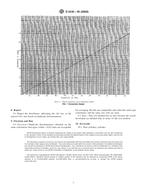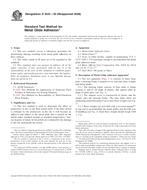We need your consent to use the individual data so that you can see information about your interests, among other things. Click "OK" to give your consent.
ASTM E299-08
Standard Test Method for Trace Amounts of Peroxides In Organic Solvents
STANDARD published on 1.4.2008
The information about the standard:
Designation standards: ASTM E299-08
Note: WITHDRAWN
Publication date standards: 1.4.2008
SKU: NS-46327
The number of pages: 4
Approximate weight : 12 g (0.03 lbs)
Country: American technical standard
Category: Technical standards ASTM
The category - similar standards:
Annotation of standard text ASTM E299-08 :
Keywords:
assay, organic, peroxides, spectrophotometric, Active oxygen, Organic chemicals, Peroxides, Solvents--paints/related coatings/materials, Spectrophotometry--absorption, Trace elements--chemicals, ICS Number Code 71.100.99 (Other products of the chemical industry)
Additional information
| Significance and Use | ||||
|
Dilute solutions of peroxides in various organic solvents frequently are used as catalysts or reaction initiators. Peroxides also can be formed through autoxidation in certain classes of compounds including ethers, acetals, dienes, and alkylaromatic hydrocarbons and present a potential safety hazard. This test method provides a procedure for determining the peroxide or active oxygen level. |
||||
| 1. Scope | ||||
|
1.1 This test method , covers organic solvents containing active oxygen in the range from 5 to 80 μg/g (ppm) or higher. By using a special reaction-absorption cell, the test method can be extended to cover the range from 0 to 5 ppm. The test method can be used to determine numerous peroxide classes of varying reactivity such as hydroperoxides, diacyl peroxides, diaroyl peroxides, peresters, and ketone peroxides. The stable di-tert-alkyl peroxides do not react under the conditions of analysis. 1.2 Solvents that can be analyzed successfully include saturated and aromatic hydrocarbons, alcohols, ethers, ketones, and esters. In addition, the test method is applicable to olefinic solvents and to certain compounds that contain α, β, and conjugated unsaturation. Solid samples that are soluble in the acetic acid-chloroform solvent also can be analyzed. 1.3 The values stated in SI units are to be regarded as standard. The values given in parentheses are for information only. 1.4 This standard does not purport to address the safety concerns, if any, associated with its use. It is the responsibility of the user of this standard to establish appropriate safety and health practices and determine the applicability of regulatory limitations prior to use. 1.5 Review the current Material Safety Data Sheets (MSDS) for detailed information concerning toxicity, first aid practices, and safety precautions. |
||||
| 2. Referenced Documents | ||||
|
Similar standards:
Historical
1.3.2008
Historical
1.3.2008
Historical
1.3.2008
Historical
1.3.2008
Historical
1.10.2013
Historical
1.3.2008



 ASTM D3206-08
ASTM D3206-08 ASTM D3207-92(2008)..
ASTM D3207-92(2008).. ASTM D3210-95(2008)..
ASTM D3210-95(2008).. ASTM D3430-95(2008)..
ASTM D3430-95(2008).. ASTM D3440-13
ASTM D3440-13 ASTM D3543-93(2008)..
ASTM D3543-93(2008).. Cookies
Cookies
